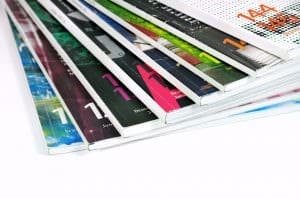Do you understand the difference between a press release and a media pitch, or an electronic press kit and an editorial calendar? Keep reading for a guide that shares the differences between the eight most common public relations documents:
- Electronic press kits
- Sample letters and fact sheets
- Editorial calendars
- Media game plans
- Press releases
- Media advisories
- Media pitches
- Media lists
What’s An Electronic Press Kit?

An electronic press kit is a one-stop-shop for journalists to find helpful information about your company. They are important to include in your public relations campaign, as they provide reporters with details about your business, high-res images and contact information so they can refer to it as they put their article together.
The key to an electronic press kit is to anticipate what the reporter may want so they can find the answers to their questions quickly and easily any time of day – without needing to wait for you to call or email them back. Rather than writing text that reads like an ad, the point is to provide just the facts by answering the 5 Ws:
- Who?
- What?
- Where?
- When?
- Why?
See examples of electronic press kits here.
How To Create An Electronic Press Kit For Your Public Relations Campaign
Remember your audience when you create your electronic press kit; you’re writing for journalists, not consumers, so make sure you write about the facts instead of using sales-y language.
I always start an electronic press kit by thinking about the questions I want to answer:
- How can you be contacted? List this at the very top so it’s easy to see. Make sure you include a phone number and email address so they can get a hold of you quickly and easily.
- What does the company do, and what makes them unique? This should be clear in the very first paragraph. If you have any facts or figures, make sure you include them.
- Is there anything your company specializes in that you need to explain?
- Would it be helpful to include details about yourself as the proprietor? For some companies, it makes sense, although for others it’s not necessary.
- How much does your product or service cost?
- Where is your company located? How can consumers contact you?
- What would be a great story about your business? We like to suggest 3-5 basic ideas for journalists visiting our clients’ electronic press kits.
- Is there anything else you think needs to be included? Some companies have an interesting story behind how they started or have some sort of initiative worth sharing.
Write your answers to these questions as clearly as possible. Then step away, do something else and come back with a fresh set of eyes. In addition to thinking about how well your electronic press kit represents your brand, consider how clearly it shares important details with someone who doesn’t know anything about your company.
Once you’ve written all the text, upload it to a separate page of your website. Include high-res images (at least 3×5 inches at 300 dots per inch, although the larger the better) to the page for journalists to download, too. Ideally, include your logo, products you sell (take photos of them on a plain white background without any props) and any other images that make sense, like maybe your headshot.
What’s A Sample Letter Or Fact Sheet?
A sample letter contains most of the same information as the electronic press kit but is limited to one page. This one-page information sheet is important to include in every single sample package you send out to journalists so they have the vital information they can reference quickly – especially contact details and the URL to your full electronic press kit.
For clients that offer a service as opposed to a product, we recommend a fact sheet to send interested journalists in lieu of a sample letter. This is the same information as in the electronic press kit as well but formatted more like a bulleted list that is easy to skim and pull specifics from quickly. This is also a fantastic place to highlight any statistics or industry research relevant to your brand.
What’s An Editorial Calendar?

A valuable tool in trying to secure media coverage is an editorial calendar. This is a list of planned stories for upcoming issues in magazines and newspapers. Advertisers use them to decide which issues to place their ads in, and public relations professionals use them to know when to pitch specific outlets and with what angle.
How To Get An Editorial Calendar
- Decide which publications you’d like to target.
- Check each media outlet’s website to see if it’s posted online or downloadable. The best places to look are in their media kit or advertiser’s section.
- If you can’t find the editorial calendar online, call the media outlet, ask for their advertising or sales department and request a media kit, which will include demographic information, ad rates and an editorial calendar. They’ll either email you a .PDF or mail a hard copy.
How To Use An Editorial Calendar For Your Public Relations Strategy
- Make note of the stories that would be applicable to your company.
- Look at the close dates listed for “Features” or “News” and check the calendar to make sure there’s still time to pitch them.
- Carefully craft a pitch that ties your company to their upcoming story and email it to the appropriate reporter at the publication. For example, if you’re pitching a food angle, you should contact the food editor. For a line of beauty products, contact a beauty writer.
What’s A Media Game Plan?
A media game plan lays out which media targets you plan to approach and from which angles each month. It’s an important step to stay organized and see an overview of your public relations strategy quickly and easily.
Here’s how to make one:
- Brainstorm media outlets in which you could see your business. As you read newspapers, magazines or blogs, think about ways your company would be a natural fit. Actually, write out a list of the media outlets you come up with.
- Think about ways you could see journalists covering your business. Are you a good fit for holiday gift guides? Write it down! Or is Mother’s Day a good fit? Add it to your list!
- As you start looking over your list of media outlets and potential angles to use when you approach the media, think about the times of year that would be best to get the ball rolling. It’s important to remember lead times, meaning how far in advance journalists start working on their stories. They vary by media type:
- Magazines: 4-6 months
- Newspapers: 6-8 weeks
- Websites and blogs: 4-6 weeks
- TV and radio: 3-4 weeks
- Write out all the months of the year, then plug in the media outlets you want to approach and the angle you plan to use for that specific outlet. Now you have your media game plan!
What’s A Press Release?

One of the most well-known public relations tools, a press release is an announcement of a newsworthy item that is issued to the press. Think about what you want to announce about your business. Does it appeal to a wide audience? Is it something the media, investors or other key constituents would be interested in?
Another good reason to write a press release is to increase your company’s search engine optimization (SEO). By writing a press release with keywords strategically slipped into the text and distributing it through a major distributor, you can help drive traffic to your website.
How To Write A Press Release For Your Public Relations Strategy
- Research keywords. If you want to increase SEO through your press release, it’s important to sprinkle high-ranking words and phrases throughout the document.
- At the top of the Press Release, write “FOR IMMEDIATE RELEASE” followed by your phone number and email address. You want to make it easy for anyone seeing your release to contact you for details.
- Follow the inverted pyramid. You want the most important information at the very top of the release. In addition to making sure the reader sees the point right away, if a reporter decides to use part of your press release in their article but they don’t have room for all of it, they can cut details from the bottom. Make sure the most important details are included in the first two sentences.
- Insert quotes. Adding a quote or two to the press release gives it a human touch and allows a reporter to cite a source without coordinating an interview. Make sure the person quoted is someone notable from your organization, such as the CEO, president or founder, and run the quotes by them first to make sure what they convey is accurate.
- Keep it brief. Clear, concise writing is vital for effective public relations. Stronger writing uses fewer words; make your press release powerful by writing with brevity.
- Include a link to your website. You want to make it easy for the reader to find out more about your business; plus, if you distribute the press release through a wire service, the additional links pointing to your website will help your SEO.
- Add a boilerplate about your company. This is a brief overview about your business; it shouldn’t be more than three to four sentences. I’d recommend adding a link to your website at the end of it, too.
What’s A Media Advisory?
A media advisory is used to provide a reporter with all the details for an upcoming event, such as a grand opening, fashion show or other noteworthy happening. When you create a media advisory you can literally write:
- Contact info: [Include your phone number and email address.]
- What: [Clearly and concisely write a brief paragraph or two about the event.]
- When: [Include both the date and time.]
- Where: [Remember the name of the venue in addition to the address.]
- Who: [This can be 1-2 sentences about you or your organization.]
- More information: [Don’t forget this step! It’s extremely important to include a link to the event page for more information.]
At Three Girls Media, we generally send advisories to appropriate media contacts a few times: once about 4-6 weeks before the event begins, again 1-2 weeks before and finally 1-2 days before as a last-minute reminder.
What’s A Media Pitch?

One of the most valuable public relations tools when it comes to securing editorial media coverage, a media pitch is a professional yet casual introduction to your product, service or business that entices the journalist to want more information, such as an interview, samples or additional details for a story or review. We always recommend you pitch by email because:
- It’s less intrusive; the journalist can take a look at the most convenient time for their schedule.
- It allows for easy access to additional information; all you need to do is include a link or two to your website and high-res photos.
- Many journalists prefer receiving pitches by email.
There are a few key elements you want to make sure you include in every single media pitch you put together:
- A strong, appealing subject line. This is what entices the journalist to open the email, so you want to grab their attention right away, give them a reason to open the email and avoid looking like spam. It can be tricky, but it’s very important!
- A hook right up front. Make it clear why their readers, viewers or listeners would care about your story idea right away – within the first two sentences.
- A little bit of background information. You don’t want to overwhelm the journalist with massive amounts of information, but you do want to give them enough to decide whether they’re interested.
- A link to more information. Always include a link for them to find out more. In fact, this is a great place to include a link to your electronic press kit.
- An offer for product samples, an interview and more information. Let them know you’re happy to work with them to provide what they need, such as product samples or an interview.
After creating your media pitch, step away from your computer for a while and then come back to proofread with fresh eyes. In addition to helping you find typos, your brain might have subconsciously come up with a better way to phrase something or a more enticing subject line idea. I also recommend having someone else read over any pitches you plan to send before distributing them; they might catch something you missed or have a helpful suggestion you can incorporate.
What’s A Media List?
A media list is a group of individual reporters, editors and producers who would potentially cover your business. A solid list is vital to the success of your public relations campaign. You can write the best pitch in the world, but if it doesn’t make it to the right person, it won’t be successful.
Start building your lists by writing down your dream publications. Go to each media outlet’s website and research the best contact. Some sites actually list all the reporters on their staff, whereas for others, you’ll need to read through the various articles to determine the best fit. As you research, save appropriate contacts you find (along with contact information and any notes) in a spreadsheet.
Once you’ve researched your initial list of dream media outlets, start thinking about similar outlets that might be a good fit as well. For example, if you came up with a magazine like Harper’s Bazaar, you might want to consider including Vogue, too. You can also Google types of publications for ideas, like “men’s websites” or “parenting magazines.”
Want to know more about various public relations documents or need help pitching the media on behalf of your company? Feel free to contact us to find out how we can help or read more about public relations in these blog posts:
- Press Release is a 4-Letter Word
- Pitch vs. Press Release – What’s the Difference?
- A Guide To The Media Pitch From A Former Member Of The Media
Special Offer:
Sign up for a complimentary consultation during December and receive an Annual Marketing Planning Guide valued at $475! We offer a 30-minute phone consultation with our CEO, and can answer your questions and discuss your specific marketing needs - no strings attached. Call 408-218-2391 or contact us today to arrange your consultation!

